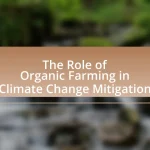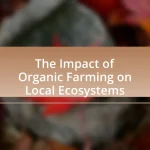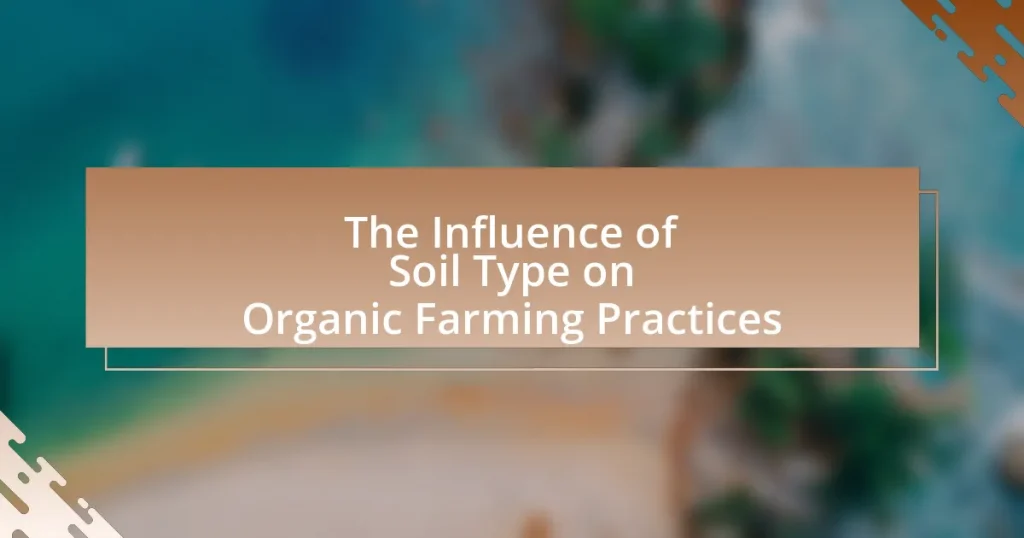The article examines the influence of soil type on organic farming practices, highlighting how different soil characteristics affect nutrient availability, water retention, and microbial activity. It categorizes soil types into sandy, clay, loamy, silt, and peat soils, discussing their unique properties and implications for crop growth and farming methods. The article emphasizes the importance of understanding soil types for effective organic farming, addressing challenges such as soil fertility and pest management, and offering practical strategies for soil improvement tailored to specific soil conditions. Additionally, it outlines best practices for organic farmers, including the use of composting and cover cropping, to enhance soil health and optimize crop yields.
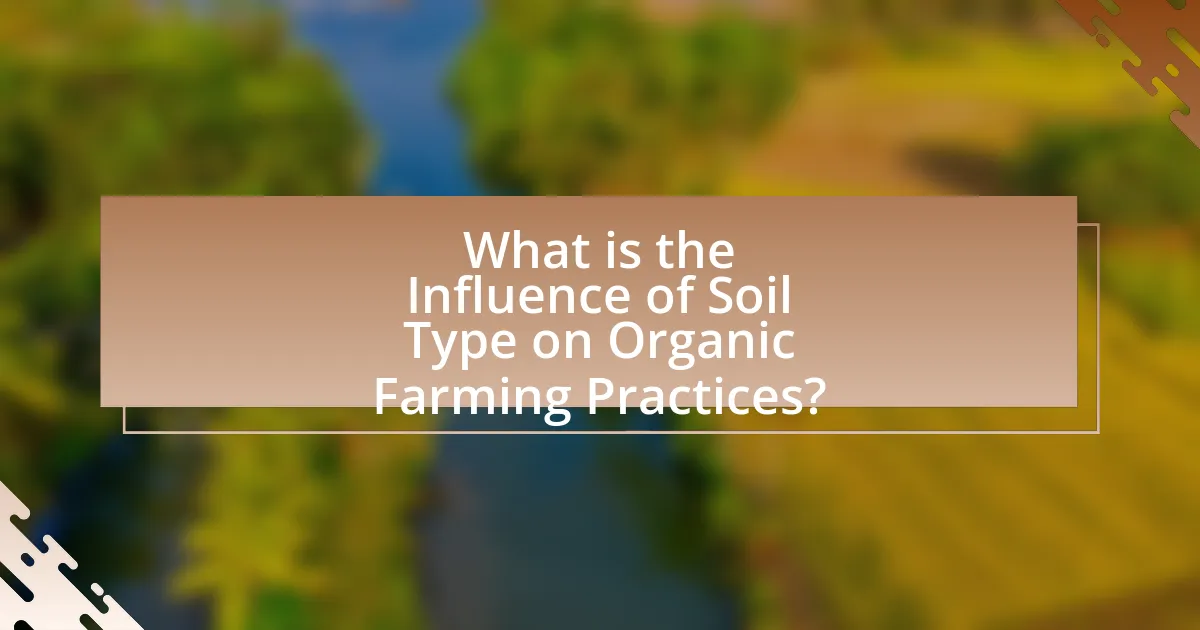
What is the Influence of Soil Type on Organic Farming Practices?
Soil type significantly influences organic farming practices by affecting nutrient availability, water retention, and microbial activity. Different soil types, such as sandy, clay, or loamy soils, have distinct physical and chemical properties that determine how well crops can grow. For instance, loamy soils, which are a balanced mix of sand, silt, and clay, typically provide optimal conditions for organic farming due to their ability to retain moisture while allowing for good drainage and aeration. Research indicates that organic farming in loamy soils can lead to higher yields and better crop quality compared to sandy soils, which drain quickly and may require more frequent irrigation. Additionally, clay soils can retain nutrients but may pose challenges with drainage, impacting root development and overall plant health. Therefore, understanding the specific characteristics of soil types is crucial for implementing effective organic farming practices that enhance sustainability and productivity.
How does soil type affect organic farming methods?
Soil type significantly affects organic farming methods by influencing nutrient availability, water retention, and microbial activity. Different soil types, such as sandy, clay, or loamy soils, have distinct physical and chemical properties that determine how well they support organic crops. For instance, loamy soils, which are a balanced mixture of sand, silt, and clay, typically provide optimal drainage and nutrient retention, making them ideal for diverse organic farming practices. In contrast, sandy soils drain quickly and may require more frequent irrigation and organic amendments to maintain fertility, while clay soils can retain water but may pose challenges with drainage and aeration, necessitating specific tillage and crop rotation strategies. Research indicates that soil health, which is influenced by its type, directly correlates with the success of organic farming, as healthy soils promote robust plant growth and resilience against pests and diseases.
What are the different soil types relevant to organic farming?
The different soil types relevant to organic farming include sandy soil, clay soil, silt soil, loamy soil, and peat soil. Sandy soil has good drainage but low nutrient retention, making it suitable for crops that require well-drained conditions. Clay soil retains moisture and nutrients but can become compacted, affecting root growth. Silt soil is fertile and retains moisture well, making it ideal for many crops. Loamy soil, a balanced mixture of sand, silt, and clay, is often considered the best for organic farming due to its fertility and structure. Peat soil, rich in organic matter, is beneficial for certain crops but can be acidic and requires management. These soil types influence organic farming practices by affecting crop selection, irrigation methods, and nutrient management strategies.
How do soil properties influence crop growth in organic farming?
Soil properties significantly influence crop growth in organic farming by affecting nutrient availability, water retention, and microbial activity. Nutrient-rich soils, characterized by high organic matter content, enhance the growth of crops by providing essential nutrients like nitrogen, phosphorus, and potassium. For instance, studies show that soils with a higher organic matter content can improve nutrient retention by up to 20%, leading to better crop yields. Additionally, soil texture impacts water retention; sandy soils drain quickly, while clay soils retain moisture, which can either benefit or hinder crop growth depending on the crop’s water needs. Furthermore, healthy soil microbiomes, fostered by organic farming practices, enhance nutrient cycling and disease resistance, further promoting robust crop development.
Why is understanding soil type important for organic farmers?
Understanding soil type is crucial for organic farmers because it directly affects crop growth, nutrient availability, and water retention. Different soil types, such as sandy, clay, or loamy soils, have distinct physical and chemical properties that influence how well plants can thrive. For instance, loamy soils are often considered ideal for agriculture due to their balanced texture, which retains moisture while allowing for good drainage and aeration. Research indicates that soil composition can impact the effectiveness of organic amendments, such as compost and manure, which are essential for maintaining soil fertility in organic farming. Therefore, recognizing the specific soil type enables farmers to tailor their practices, optimize yields, and enhance sustainability in their farming systems.
What challenges do organic farmers face related to soil type?
Organic farmers face significant challenges related to soil type, primarily due to variations in soil fertility, drainage, and texture. These factors directly impact crop yields and the effectiveness of organic farming practices. For instance, sandy soils may drain too quickly, leading to nutrient leaching, while clay soils can retain too much water, causing root rot and other issues. Research indicates that approximately 30% of organic farmers report soil fertility as a major constraint, highlighting the need for tailored soil management strategies to enhance productivity.
How can soil type impact pest and disease management in organic farming?
Soil type significantly impacts pest and disease management in organic farming by influencing the microbial community, nutrient availability, and moisture retention. Different soil textures, such as sandy or clay soils, affect water drainage and aeration, which can either promote or inhibit pest populations and disease pathogens. For instance, clay soils retain moisture, potentially creating favorable conditions for fungal diseases, while sandy soils drain quickly, reducing disease incidence but may require more frequent irrigation. Research indicates that diverse soil microbial communities can suppress pests and diseases through natural antagonism, highlighting the importance of soil health in organic practices. Thus, understanding soil type allows organic farmers to tailor their pest and disease management strategies effectively.
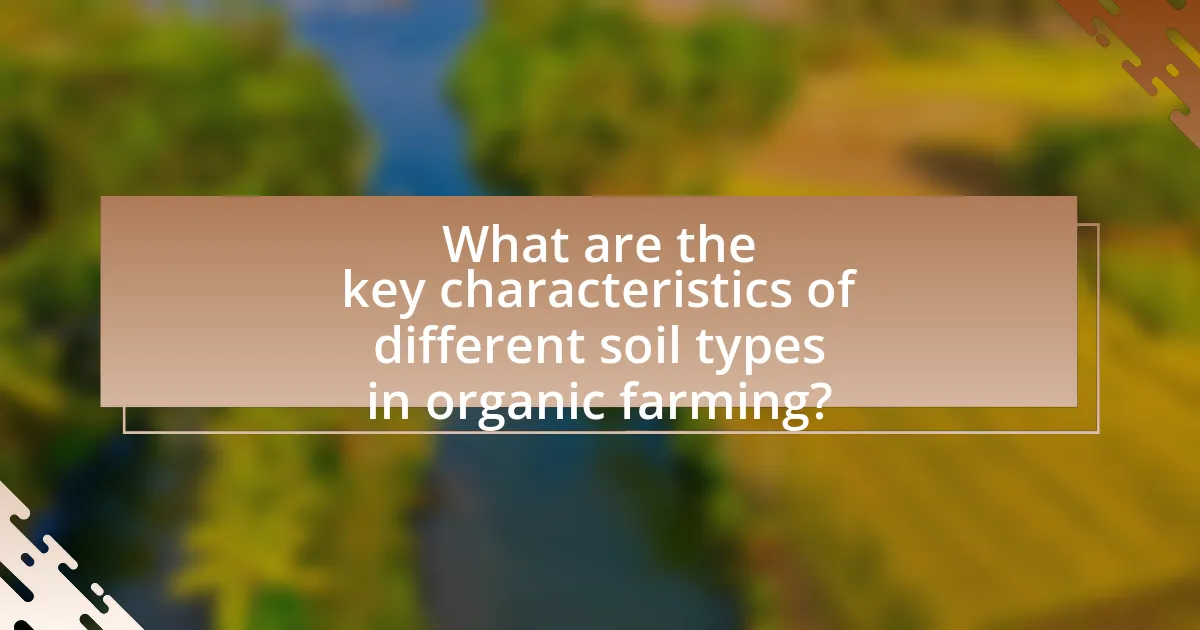
What are the key characteristics of different soil types in organic farming?
The key characteristics of different soil types in organic farming include texture, structure, nutrient content, and moisture retention. Sandy soils, for example, have large particles that allow for good drainage but low nutrient retention, making them less ideal for organic farming without amendments. Clay soils, on the other hand, have small particles that retain moisture and nutrients well but can become compacted, hindering root growth. Loamy soils, which are a balanced mix of sand, silt, and clay, are often considered the best for organic farming due to their ability to retain moisture and nutrients while providing good drainage. Additionally, organic matter content is crucial across all soil types, as it enhances soil fertility and microbial activity, essential for sustainable organic farming practices.
How do sandy soils influence organic farming practices?
Sandy soils significantly influence organic farming practices by providing excellent drainage and aeration, which can enhance root development and reduce the risk of root diseases. However, their low nutrient and water retention capacity necessitates the frequent application of organic amendments, such as compost and mulch, to maintain soil fertility and moisture levels. Research indicates that sandy soils can lead to increased reliance on organic fertilizers, as they typically require more inputs to sustain crop yields compared to loamy or clay soils. This dynamic emphasizes the importance of tailored organic farming strategies that address the specific challenges posed by sandy soil conditions.
What are the advantages and disadvantages of sandy soils for organic crops?
Sandy soils offer both advantages and disadvantages for organic crops. The primary advantage of sandy soils is their excellent drainage and aeration, which promotes root development and reduces the risk of waterlogging. This characteristic is beneficial for crops that require well-drained conditions, as it allows for better access to oxygen and nutrients. Additionally, sandy soils warm up quickly in the spring, enabling earlier planting and potentially longer growing seasons.
Conversely, the main disadvantage of sandy soils is their low nutrient and water retention capacity. Sandy soils often require more frequent irrigation and fertilization to support organic crops, which can increase labor and resource costs. Furthermore, the rapid leaching of nutrients can lead to challenges in maintaining soil fertility over time, necessitating the use of organic amendments to replenish essential nutrients.
How can organic farmers improve sandy soil conditions?
Organic farmers can improve sandy soil conditions by incorporating organic matter, such as compost or cover crops, to enhance soil structure and moisture retention. This practice increases the soil’s nutrient-holding capacity and promotes beneficial microbial activity, which is essential for plant growth. Research indicates that adding organic matter can improve sandy soils’ water retention by up to 50%, significantly benefiting crop yields. Additionally, using mulches can help reduce evaporation and further improve moisture levels in sandy soils.
What role do clay soils play in organic farming?
Clay soils play a crucial role in organic farming by providing excellent water retention and nutrient-holding capacity. This type of soil can store moisture, which is essential for crops, especially in dry periods, and it retains nutrients such as nitrogen, phosphorus, and potassium, which are vital for plant growth. Studies have shown that clay soils can improve soil structure and enhance microbial activity, promoting a healthy ecosystem that supports organic farming practices. For instance, research indicates that clay-rich soils can increase organic matter content, leading to better soil fertility and crop yields.
What are the benefits of clay soils for organic agriculture?
Clay soils offer several benefits for organic agriculture, primarily due to their high nutrient retention and moisture-holding capacity. These soils can store essential nutrients like potassium, calcium, and magnesium, which are vital for plant growth. Additionally, clay soils have a greater ability to retain water compared to sandy soils, reducing the need for frequent irrigation and helping to maintain consistent moisture levels for crops. Research indicates that clay soils can improve soil structure and promote beneficial microbial activity, which enhances nutrient cycling and overall soil health. This combination of nutrient availability and moisture retention makes clay soils particularly advantageous for organic farming practices.
How can organic farmers manage the challenges of clay soils?
Organic farmers can manage the challenges of clay soils by implementing practices that improve soil structure and drainage. These practices include incorporating organic matter, such as compost or well-rotted manure, which enhances soil aeration and water retention. Research indicates that adding organic matter can increase soil porosity by up to 30%, facilitating better root growth and nutrient uptake. Additionally, crop rotation and cover cropping can help break up compacted clay layers, further improving soil health and fertility. These methods not only address the physical limitations of clay soils but also promote a sustainable farming ecosystem.
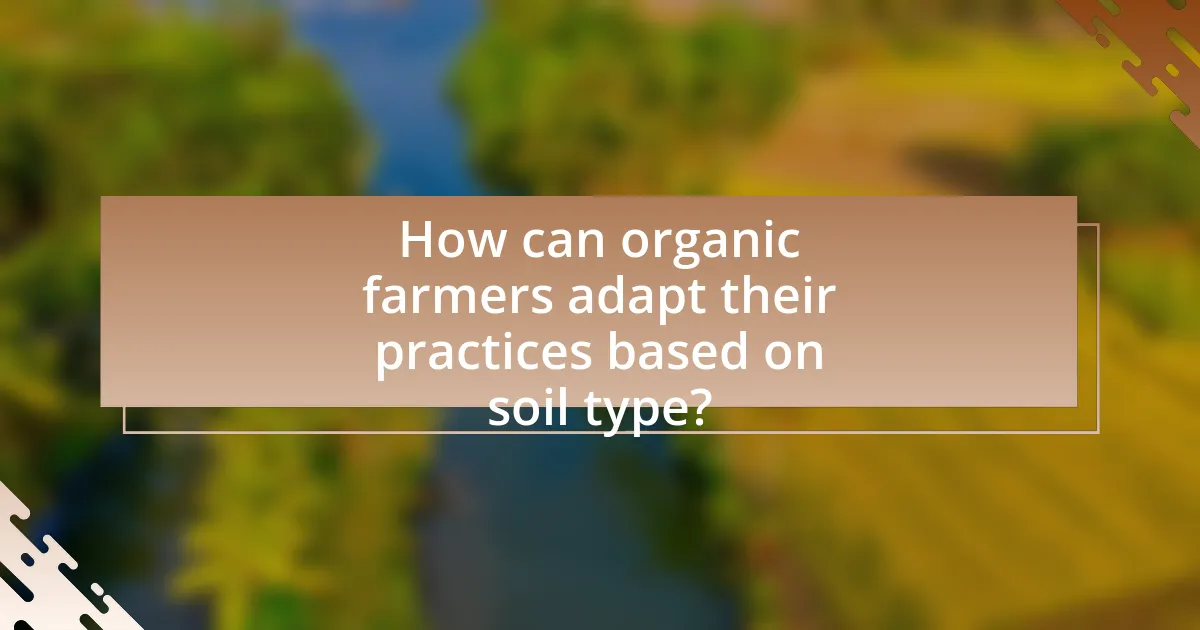
How can organic farmers adapt their practices based on soil type?
Organic farmers can adapt their practices based on soil type by implementing specific cultivation techniques that enhance soil health and crop yield. For instance, in sandy soils, which drain quickly and have low nutrient retention, farmers may increase organic matter through cover cropping and compost application to improve moisture retention and nutrient availability. Conversely, in clay soils, which retain water but can become compacted, farmers might utilize raised beds and crop rotation to enhance drainage and aeration, thereby promoting root growth and reducing disease risk. Research indicates that these tailored practices can lead to improved crop performance and sustainability, as evidenced by studies showing that organic matter amendments can increase yields by up to 30% in nutrient-poor soils.
What soil management techniques are effective for different soil types?
Effective soil management techniques vary by soil type, with specific practices tailored to enhance soil health and productivity. For sandy soils, techniques such as organic matter addition, cover cropping, and mulching improve moisture retention and nutrient availability. Clay soils benefit from practices like reduced tillage, which minimizes compaction, and the incorporation of organic amendments to enhance structure and drainage. Loamy soils, being well-balanced, can utilize crop rotation and integrated pest management to maintain fertility and biodiversity. Research indicates that these tailored approaches lead to improved soil quality and crop yields, supporting sustainable organic farming practices.
How can cover cropping benefit various soil types in organic farming?
Cover cropping benefits various soil types in organic farming by enhancing soil structure, improving nutrient availability, and reducing erosion. For instance, in sandy soils, cover crops can increase organic matter content, which improves water retention and nutrient-holding capacity. In clay soils, cover crops help to break up compaction, allowing for better aeration and drainage. Additionally, cover crops can fix nitrogen in the soil, particularly legumes, which is beneficial across all soil types. Research indicates that cover cropping can increase soil organic carbon levels by 0.1 to 0.3% annually, contributing to overall soil health and fertility.
What role does composting play in enhancing soil health for organic farming?
Composting plays a crucial role in enhancing soil health for organic farming by improving soil structure, increasing nutrient availability, and promoting microbial activity. The organic matter in compost enriches the soil, leading to better water retention and aeration, which are essential for healthy root development. Additionally, compost provides a balanced supply of nutrients, including nitrogen, phosphorus, and potassium, which are vital for plant growth. Research indicates that compost application can increase soil organic carbon levels by 10-30%, thereby enhancing soil fertility and biodiversity. This improvement in soil health ultimately supports sustainable agricultural practices and increases crop yields in organic farming systems.
What best practices should organic farmers follow based on soil type?
Organic farmers should tailor their practices to specific soil types to optimize crop health and yield. For sandy soils, best practices include increasing organic matter through compost and cover crops to enhance water retention and nutrient availability. In clay soils, farmers should focus on improving drainage and aeration by incorporating organic amendments like well-rotted manure, which can help prevent compaction and promote root growth. For loamy soils, maintaining a balanced approach with crop rotation and diverse planting can maximize fertility and resilience against pests. Research indicates that these tailored practices lead to improved soil structure and fertility, ultimately enhancing productivity in organic farming systems.
How can soil testing inform organic farming decisions?
Soil testing can inform organic farming decisions by providing essential data on nutrient levels, pH, and soil composition, which directly influence crop selection and management practices. By analyzing soil samples, farmers can identify deficiencies or excesses in nutrients such as nitrogen, phosphorus, and potassium, allowing them to tailor their organic amendments and fertilizers accordingly. For instance, a study published in the “Journal of Soil and Water Conservation” found that targeted soil testing led to a 20% increase in crop yields by optimizing nutrient management in organic systems. This data-driven approach enables farmers to enhance soil health, improve crop productivity, and make informed decisions that align with organic farming principles.
What are the common mistakes to avoid when managing soil in organic farming?
Common mistakes to avoid when managing soil in organic farming include neglecting soil testing, over-reliance on compost, and inadequate crop rotation. Neglecting soil testing can lead to unbalanced nutrient levels, affecting plant health and yield. Over-reliance on compost may result in nutrient imbalances if not properly managed, as compost varies in nutrient content. Inadequate crop rotation can deplete specific nutrients and increase pest and disease pressure, undermining soil health. These practices can significantly impact the sustainability and productivity of organic farming systems.
What practical tips can enhance organic farming practices based on soil type?
To enhance organic farming practices based on soil type, farmers should tailor their approaches to the specific characteristics of their soil. For sandy soils, incorporating organic matter such as compost can improve water retention and nutrient availability. In clay soils, practicing crop rotation and using cover crops can enhance soil structure and aeration, reducing compaction. For loamy soils, maintaining a balanced pH through regular soil testing and applying organic amendments like lime or sulfur can optimize nutrient uptake. Research indicates that these practices lead to improved crop yields and soil health, as evidenced by studies showing that organic matter increases soil fertility and microbial activity, essential for sustainable farming.


